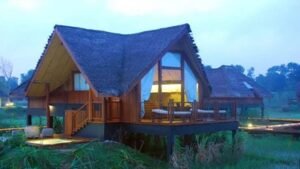
Nestled in the heart of Sri Lanka’s cultural triangle, Dambulla Cave Temple is a majestic journey through ancient art, spirituality, and history. Designated as a UNESCO World Heritage site, this breathtaking temple complex – also known as the Golden Temple of Dambulla – stands proudly atop a massive rock outcrop, offering a spectacular view of the surrounding plains. Home to sacred murals and a stunning array of Buddha statues, the temple reveals the depths of Sri Lanka’s religious artistry and the devotion of those who have maintained it over centuries. For both foreign tourists and local travelers, Dambulla Cave Temple is an unmissable portal into the rich legacy of Buddhist heritage.
Discovering the Five Caves of Dambulla
The Dambulla Cave Temple is divided into five distinct caves, each with its own aura and theme. Dating back to the 1st century BCE, these caves are filled with vivid murals, ancient paintings, and statues that represent Buddha’s journey and teachings. The five caves – named Devaraja Viharaya, Maharaja Viharaya, Maha Aluth Viharaya, Pachima Viharaya, and Devana Alut Viharaya – house a total of 153 statues, including a colossal 14-meter reclining Buddha. As you move from cave to cave, the artistry transforms, illustrating the evolution of Sri Lankan craftsmanship through the centuries.
Each mural tells a story; some depict Buddha’s life events, while others illustrate historic encounters between local kings and monks. The murals, painted in striking shades of red, blue, and gold, still retain their vibrant hues after thousands of years, offering visitors a chance to experience what ancient pilgrims might have seen.
Legends and Mysteries of Dambulla
According to local legend, the temple was used as a refuge by King Valagamba during his exile in the 1st century BCE. When he regained the throne, he transformed these caves into a magnificent temple complex as a token of gratitude. Centuries later, King Nissanka Malla adorned the temple with gold, giving it the name Golden Temple. Over the years, each ruler added their own artistic contribution, further enhancing the beauty and sanctity of this remarkable site. Visitors can still feel the powerful, spiritual energy that has drawn monks and pilgrims here for over two millennia.
A Feast for the Senses
Beyond the art and architecture, Dambulla Cave Temple is also a sensory experience. The caves exude a cool, earthy scent mixed with the subtle aroma of incense. The serene atmosphere, coupled with the gentle flicker of oil lamps illuminating the statues, creates a deeply spiritual ambiance. Each cave’s unique acoustics capture even the softest whispers, adding a mystical layer to the experience.
Distance and Transportation Options
Whether you’re coming from bustling Colombo or historic Kandy, Dambulla Cave Temple is easily accessible. Here’s a quick guide to the distance and transportation options:
Distance to Dambulla Cave Temple:
- From Colombo City: Approximately 150 km
- From Colombo Bandaranaike International Airport (Katunayake): Approximately 130 km
- From Kandy City: Approximately 70 km
- From Galle City: Approximately 240 km
- From Mattala Rajapaksa International Airport: Approximately 230 km
Transportation Options:
- By Road: Renting a private car or taxi is the most convenient option, providing flexibility and comfort. A direct road trip from Colombo or Kandy offers scenic views along Sri Lanka’s interior landscape.
- By Air: Domestic flights to Sigiriya Airport, just 20 minutes from Dambulla, are available for those seeking a quick route. From Sigiriya, you can arrange a taxi or tuk-tuk to the temple.
- By Train: While Dambulla lacks a direct train station, travelers can take a train to Habarana or Matale and complete the journey by road. This option gives an immersive view of Sri Lanka’s countryside.
- By Bus: Buses are available from Colombo and Kandy to Dambulla, making this an economical choice for solo travelers or small groups.
- By Sea: Though less direct, some travelers may reach Colombo or Trincomalee via international sea routes and then journey to Dambulla by land.
Planning Your Visit to Dambulla Cave Temple
For a comprehensive visit, plan to arrive early to avoid the midday heat and fully appreciate the temple’s architecture and art. The temple is open daily, but the caves’ sacred ambiance is best enjoyed during quiet morning hours. Remember to dress respectfully and remove your shoes at the entrance as a mark of respect to this sacred site.





